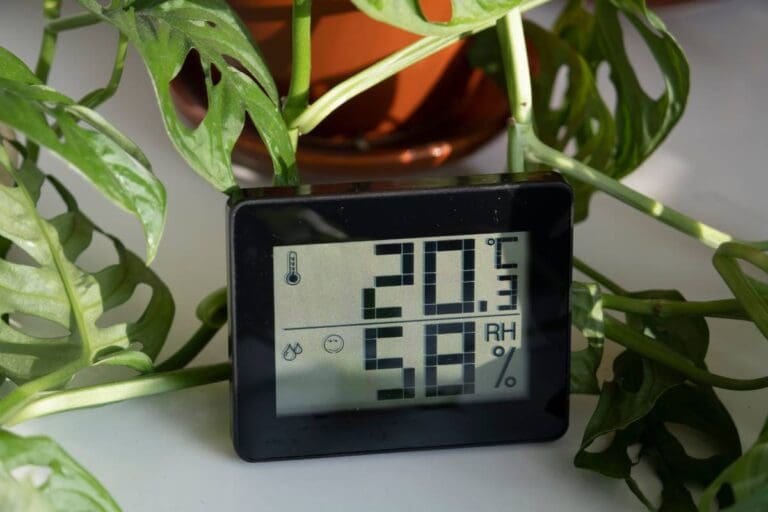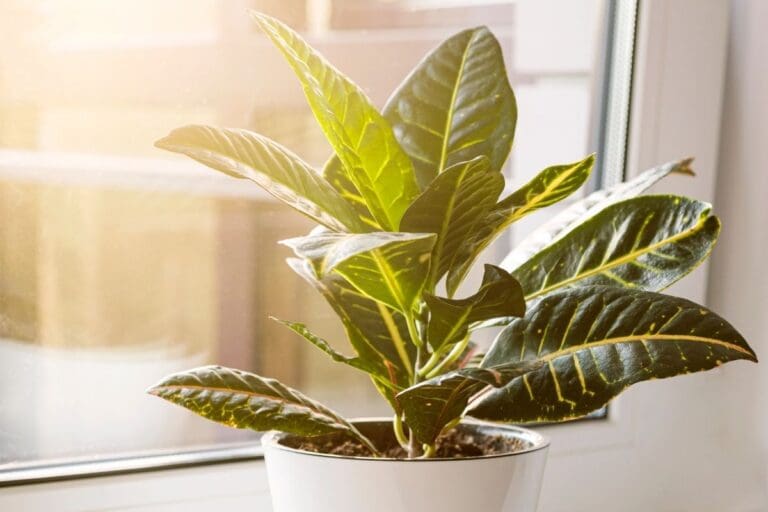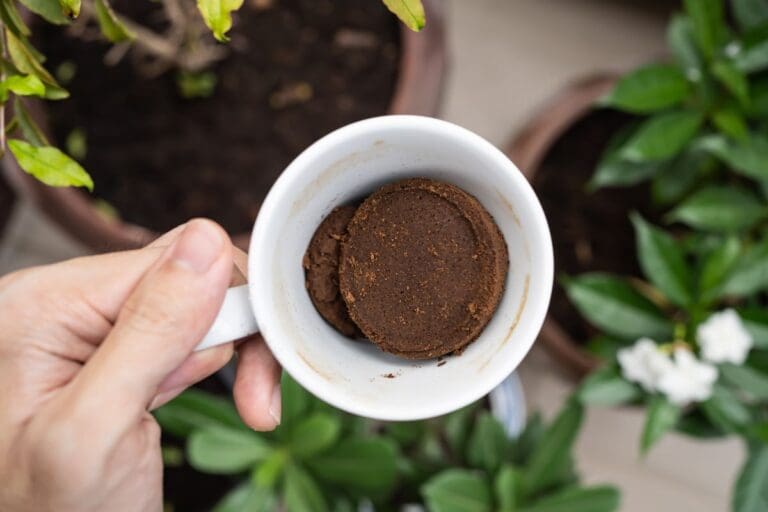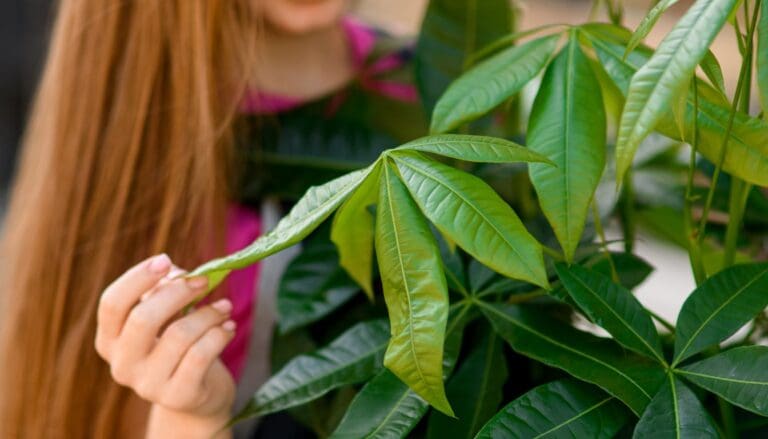9 Common Houseplant Diseases: Signs, Identification, & Treatment
Growing houseplants is rewarding and satisfying. The demand for houseplants is increasing day by day. But one thing that can ruin the entire experience is when your houseplant has diseases.
Fungal leaf spot, root rot, powdery mildew, bacterial leaf spot, and anthracnose are some common houseplant diseases. Many diseases can kill your plant, but you can treat some. But prevention is always better than cure, so try to maintain a good environment to keep your houseplants healthy.
In this article, we will discuss the common houseplant diseases along with their identification, treatment, and prevention methods. So, keep reading.
Please note: Simplify Plants is reader-supported. Some links in the post are affiliate links and I get a commission from purchases made through links in the post.
1. Fungal Leaf Spot

Fungal leaf spot disease is a common disease caused by fungi on plants that live in moist and cool conditions.
One of the common reasons behind this is overwatering.
When you overwater your plant, the soil remains moist, creating the ideal condition.
Many people spill water on the foliage while watering their plants.
When the foliage remains wet, they create the ideal environment for this disease.
If your houseplant has fungal leaf spots, you will notice:
- Spots on leaves (yellow, brown, black, red, or tan)
- Distorted leaves
- Loss of leaves
How to treat the fungal leaf spot disease?
Use the following steps to treat the fungal leaf spot disease:
- Prune all the affected leaves as soon as you notice the spots.
- Get rid of the debris on the potting soil, as this can also be the home of fungi.
- You can also use a fungicide in case of a serious condition.
To prevent fungal leaf spot disease, keep the following in mind:
- Avoid overwatering your plants.
- Water the plants during the morning or daytime.
- Don’t spill water on the leaves while watering.
- Keep the plants in a well-aerated space.
- Always remove the debris that collects on the potting soil.
2. Root rot

Root rot is one of the most common and deadly diseases that is caused due to overwatering, poor-draining soil, or a poor drainage system.
When the soil doesn’t dry fast, the roots remain wet for too long, and that blocks the oxygen supply.
Due to a lack of oxygen, the roots start to rot.
If you don’t identify the signs on time, the rot can spread and affect the stem, thus causing stem rot.
Different pathogens can cause root rot. Some common ones are:
- Rhizoctonia
- Pythium
- Fusarium
- Phytophthora
A plant undergoing root rot will give out many signs:
- Wilting leaves
- Yellow leaves
- Brown or black leaves
- Mushy roots
- Brown or black roots
- Foul smelling soil
- Falling leaves
- Wet soil
If you notice any of these signs, you must act quickly and treat the problem.
How to treat root rot?
Here is how you treat a plant with root rot:
- Take the plant out of its pot and clean the roots.
- Prune all the affected leaves and stems.
- Prune the brown and mushy roots with sharp and sterilized pruners.
- Spray fungicide on the healthy roots.
- Take a new pot and prepare a fresh potting mix.
- Repot the plant in the new pot and provide the ideal growing conditions.
- If the condition worsens, you must eliminate the entire plant.
Now, let’s understand how you can prevent root rot.
- Never overwater your plant.
- Don’t follow the same watering schedule blindly.
- Make sure the pot has drainage holes to drain the excess water.
- Use well-draining potting soil.
- Keep the plant in a well-lit spot with proper airflow to allow the soil to dry quickly.
- Never use old soil while repotting the plant.
3. Powdery Mildew

Powdery mildew is a common fungal disease that doesn’t usually kill plants.
Some common reasons behind powdery mildew are:
- Low temperatures
- High humidity
- Lack of airflow
- Overwatering
Different species of the Oidium cause powdery mildew.
This generally occurs in winter when the temperature remains low.
If you overwater the plant during this time or keep the leaves wet, powdery mildew will occur on your plant.
The fallen debris also becomes ideal for powdery mildew growth.
Although powdery mildew might not kill your plant, it can spread from the affected plant to other houseplants if you don’t control it on time.
Signs of powdery mildew are:
- White and powdery spots on leaves
- Distorted foliage
- Falling leaves
How to treat powdery mildew?
Here are the steps with which you can make powdery mildew go away and bring your plant back to normal:
- Prune the affected leaves and stems with sterilized pruners.
- Remove the debris over the potting soil.
- Discard all the parts mentioned above.
- Allow proper airflow around the plant.
- Avoid overwatering and keeping the leaves wet.
- Keep the affected plant away from other plants till it recovers.
4. Bacterial Leaf Spot

Like most diseases, bacterial leaf spot takes place when the conditions are cool and wet.
Bacterial leaf spots can be deadly in severe conditions and can even kill your plants.
In more serious conditions, it will affect the leaves, but if the situation worsens, it will affect the entire plant.
Some common reasons behind bacterial leaf spots are:
- Lack of airflow
- Incorrect watering
- Low light
- Using old soil while repotting
You will notice black spots with a yellow outline on the leaves of the plant affected with bacterial leaf spot disease.
These can spread to the entire leaves and even the stems.
When the spots spread to the stems, it might become difficult to save the plant.
How to treat bacterial leaf spots?
If the bacterial leaf spots are at the initial stage, which means they have not started spreading, prune the affected leaves and parts.
Once the leaf spots spread, you start noticing them on the leaves, stems, and even the potting soil!
In this condition, you need to discard the plant and the soil.
So, preventing is better than trying to cure the plant.
Here are the steps for preventing bacterial leaf spot disease:
- Don’t water the leaves while watering the plants.
- Don’t keep the plants crowded and allow proper airflow around them.
- Water during the morning so the soil can dry out.
- Always clean the debris whenever you notice it on the soil.
- Don’t use old potting soil.
5. Anthracnose

Like all diseases, anthracnose is caused when your plant doesn’t get the ideal conditions.
Some reasons behind this are:
- Not cleaning the debris on the potting soil
- Using old and contaminated soil
- Lack of airflow
Anthracnose mostly affects the foliage plants and prefers humid and warm conditions.
The good thing is you can fix your plants as long as the disease has not reached a severe state.
Fundi like Gloeosporium and Collectrotrichum can give rise to anthracnose.
If you bring home an already infected plant, the disease can spread from it to your other houseplants.
Some signs of anthracnose on your plants are:
- Yellow leaf tips
- Brown spots
- Leaf loss
How to treat anthracnose?
Here’s how you treat anthracnose on your houseplant:
- Prune all the infected parts with a sharp and disinfected pruner.
- Discard all the pruned parts.
- Apply a fungicide created to treat anthracnose.
You can prevent anthracnose in the following ways:
- Avoid using old and contaminated potting mix while repotting your plants.
- Don’t keep the plants in crowded spots with little or no airflow.
- Don’t let debris collect on the potting soil.
- Always use fresh potting mix for repotting.
- Inspect the plants carefully before buying them.
6. Botrytis Blight or Gray Mold

Botrytis blight is a common yet serious disease that is caused due to fungi.
The fungi that cause this disease thrive in dead debris that collects over the potting mix.
You notice gray spores on the debris that can spread to the leaves if you spill water on them while watering.
When the fungal spores dry, they spread to the air and can risk other houseplants.
This disease can kill the infected plants and is even more harmful to flowering plants.
Some signs of Botrytis blight on your houseplant are:
- Brown spots
- Gray bull’s-eye patterns on leaves
- Encircling spots on the stems
- A layer of thick grayish mold on dead plant debris
How to treat Botrytis blight or gray mold?
Try these if your plant is affected by the Botrytis blight disease.
- First, remove all the affected leaves and stems with sterilized scissors.
- Don’t keep the humidity too high around the plant.
- Keep the plant in a well-aerated spot.
- Never water the plant in the evening or at night.
- Use a fungicide to treat the disease.
Make sure you take these steps fast if you want to save the affected plant.
Also, keep the affected plant away from other houseplants till it recovers.
7. Sooty Mold

Sooty mold is a fungal disease that occurs due to pests.
Pests feed on the plant’s sap and excrete a sticky substance called honeydew.
This honeydew creates the ideal environment for sooty mold as the fungi feed on them.
Some pests that can cause this problem are:
- Mealybugs
- Aphids
- Scales
- Whiteflies
Sooty mold is usually harmless and doesn’t damage the plant, but you would want to remove it because it doesn’t look good.
How to treat sooty mold?
You first need to eliminate the pests to get rid of sooty mold.
Pests can heavily damage your plants and even kill them if you don’t treat the problem promptly.
Here are a few steps for removing pests:
- Give the plant a good wash to dislodge as many pests as possible.
- Prune the heavily infested areas.
- Make a Neem oil solution by mixing Neem oil with water. Spray the solution all over the plant.
- Use insecticidal soap to remove the pests.
You can then wipe the leaves with a damp cloth to remove the mold.
You can also remove the parts affected by sooty mold by pruning them with sharp and sterilized tools.
8. White Mold

White mold occurs when you overwater your plant or use a poor drainage system.
It can also occur when you use already infected potting soil.
This is not deadly and won’t kill your plant, but it will make the potting soil look unappealing.
A white layer over the potting soil is a clear sign of white mold.
How to treat white mold?
The only way to treat white mold is by removing the upper layer of the potting soil that has the white mold layer.
You can also repot the plant in fresh potting mix to be on the safe side.
But, if you are thinking of preventing this, here are the steps:
- Don’t overwater your plants. Water only when the top inches of the soil go dry.
- Provide proper light and airflow around the plant.
- Make sure the pot has drainage holes to let the excess water drain out of the system.
- Don’t repot the plant in old potting soil.
9. Viral diseases

Viral diseases are common and deadly and can occur for various reasons.
Some common reasons that lead to viral diseases are:
- People who handle tobacco can transfer the virus if they touch their houseplants without washing their hands first.
- Pruning houseplants with contaminated tools.
- Plants propagated from infected mother plants.
- Aphids transfer the virus to your healthy plant while sucking the sap from them.
Some common signs of virus infection are:
- Distorted leaves
- Stunted growth
- Distorted blooms
- Pale or discolored flowers
- Yellow spots in leaves
- Pale or dark patches on leaves
- Mosaic and mottling patterns
How to treat viral diseases on plants?
Viral diseases are deadly and will ultimately kill the plant, so you must discard the affected plant and start with a new one.
What you can do is prevent the viral diseases before they affect your dear houseplants.
Here are a few things to keep in mind:
- Never get plants without checking them thoroughly. Make sure the plants are free of pests and diseases.
- Always isolate the plant once you bring it home. Keep it with the other houseplants once you are sure the plant is healthy.
- Always disinfect the pruners and other tools before and after use.
- Never propagate from a sick plant.
- If you smoke or handle tobacco, wash your hands before dealing with the houseplants.
Reference: The Pennsylvania State University, Houseplant Problems, HOUSEPLANT DISEASES & DISORDERS, Mississippi State University.
Recommended Garden Supplies
| Product Image | Our Recommended Gardening Supplies | Check Offers! |
|---|---|---|
Top Top
Top
Top
Top
Top
Top
Top
Top | rePotme Houseplant and Tropical Classic Potting Soil Mix | Check Offer On Amazon |
 Top
Top
Top
Top
Top
Top
Top
Top | Espoma Organic Indoor Plant Food | Check Offer On Amazon |
 Top
Top
Top
Top
Top
Top
Top
Top | GooingTop LED Grow Light 6000K Full Spectrum Clip Plant Growing Lamp | Check Offer On Amazon |
 Top
Top
Top
Top
Top
Top
Top
Top | Soil Moisture Meter | Check Offer On Amazon |
 Top
Top
Top
Top
Top
Top
Top
Top | Govee Hygrometer Thermometer, Bluetooth Enabled! | Check Offer On Amazon |
 Top
Top | LEVOIT Humidifiers for Large Room(Best For Plants) | Check Offer On Amazon |
 Top
Top
Top
Top
Top
Top
Top
Top | Upgraded DIY Automatic Drip Irrigation Kit, 15 Potted Houseplants Support | Check Offer On Amazon |
 Top
Top
Top
Top
Top
Top
Top
Top | Stainless Steel Heavy Duty Gardening Tool Set | Check Offer On Amazon |
 Top
Top
Top
Top
Top
Top
Top
Top | Bonide Insecticidal Soap | Check Offer On Amazon |
 Top
Top
Top
Top
Top
Top
Top
Top | Bonide 32 oz Spray Neem Oil for Organic Gardening | Check Offer On Amazon |
 Top
Top
Top
Top
Top
Top
Top
Top | Garden Safe Fungicide | Check Offer On Amazon |






